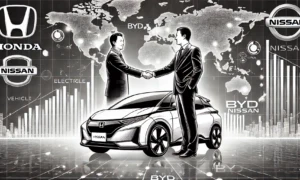Introduction
Taiwan Semiconductor Manufacturing Company (TSMC) is not just a leader in semiconductor manufacturing—it is the very backbone of the modern technology ecosystem. As the world’s largest and most advanced contract chipmaker, TSMC plays a crucial role in powering everything from smartphones and laptops to AI systems and electric vehicles. The company’s meteoric rise from a small semiconductor foundry in Taiwan to a global powerhouse is a testament to its visionary leadership, relentless innovation, and strategic positioning within the tech industry.
This case study explores how TSMC achieved dominance in the semiconductor market, the factors behind its success, and how it continues to drive global technological progress.
The Genesis of TSMC
Founded in 1987 by Morris Chang, TSMC was created as the world’s first dedicated semiconductor foundry, designed to address the growing demand for custom chips while helping to mitigate the costs associated with semiconductor manufacturing. At the time, companies like Intel and AMD were designing and producing their own chips, but TSMC’s model—focusing solely on the manufacturing of chips designed by other companies—was a bold move. It quickly became clear that TSMC’s specialization would allow it to serve a wide range of customers, reducing their entry barriers to chip production.
TSMC’s vision was simple yet transformative: become the partner of choice for companies wanting to bring their chip designs to life, without investing heavily in manufacturing capabilities. This made TSMC a critical player in the evolution of the semiconductor industry and a catalyst for the growth of the digital age.
Key Factors Behind TSMC’s Success
1. Focus on Advanced Technology
One of TSMC’s major strategic advantages has been its focus on staying ahead in semiconductor technology. From the outset, TSMC committed itself to developing cutting-edge manufacturing processes. The company led the industry by consistently investing in advanced process nodes, such as 7nm, 5nm, and even 3nm chips, which offer better performance, efficiency, and smaller form factors. This enabled TSMC to work with top-tier clients like Apple, Nvidia, and AMD, who required the most advanced chips for their flagship products.
2. Foundry-Only Business Model
TSMC’s business model, centered around being a pure-play foundry, allowed it to focus on manufacturing excellence while avoiding the distractions of designing its own chips. Unlike its competitors like Intel, which both designs and manufactures chips, TSMC operates strictly as a foundry, meaning it doesn’t compete with its customers. This positioning has allowed TSMC to build deep, long-term relationships with some of the world’s largest tech companies, who rely on the company to turn their chip designs into reality.
3. Massive Scale and Global Reach
TSMC’s scale is unparalleled in the semiconductor industry. The company operates over 20 fabrication plants worldwide, including the U.S., Japan, and China, and is in the process of expanding its footprint in several locations, including a major plant in Arizona. This massive production capacity allows TSMC to serve customers across a diverse range of industries, from consumer electronics to automotive to artificial intelligence.
4. Strategic Partnerships and Customer Relationships
TSMC’s ability to establish strong relationships with leading technology companies is one of the keys to its success. The company partners closely with customers such as Apple, Qualcomm, AMD, and Nvidia to develop custom chips that meet their specific needs. These partnerships allow TSMC to drive mutual growth while cementing its position as the go-to foundry for high-end semiconductor production. Additionally, TSMC has worked closely with key players in the chip design ecosystem, including tool suppliers like ASML, to ensure it has access to the latest advancements in photolithography, which is crucial for manufacturing smaller, more powerful chips.
5. Exceptional Operational Excellence
Operational excellence is at the heart of TSMC’s success. The company has made continuous improvements in its manufacturing processes, adopting automation and AI-driven systems to enhance production efficiency. TSMC has also been recognized for its highly skilled workforce, rigorous quality control systems, and commitment to sustainability, all of which contribute to its competitive edge.
Key Innovations and Technology Leadership
1. Leading Process Nodes
TSMC’s leadership in cutting-edge chip manufacturing nodes has made it the go-to partner for technology companies that require the most advanced chips. The company’s 7nm, 5nm, and 3nm nodes are considered some of the most sophisticated manufacturing processes in the world, enabling the production of ultra-efficient chips with high processing power. Apple, for instance, has used TSMC’s 5nm process for its A14 Bionic chip, powering its latest iPhone models.
2. Research and Development Investments
TSMC’s massive investments in R&D have been critical in maintaining its leadership position. The company spends billions each year to develop next-generation manufacturing technologies, including extreme ultraviolet (EUV) lithography, which is essential for creating smaller, more powerful chips. The company’s R&D investments also focus on developing new materials, enhancing chip packaging technologies, and improving energy efficiency in chip production.
3. Pioneering 3D IC and Advanced Packaging
In recent years, TSMC has also focused on advancing its 3D integrated circuit (IC) technology, which allows multiple chips to be stacked on top of each other, improving performance without increasing the footprint. This innovation is particularly important for applications like mobile devices and high-performance computing, where space constraints and power consumption are critical factors.
Challenges and Strategic Responses
| Challenge | Strategic Response |
| Intense Competition | Continued innovation in advanced process nodes and strong customer relationships to secure top-tier clients. |
| Geopolitical Tensions and Supply Chain Risks | Diversification of production facilities globally, including new plants in the U.S. and Japan, to mitigate risks. |
| Increasing Demand for Chips | Expansion of capacity through new fabs and advanced technologies like EUV and 3D IC to keep pace with demand. |
| R&D Investment and High Costs | Continued heavy investment in R&D and innovation while maintaining operational efficiency to balance costs. |
Impact on the Tech Industry and Global Economy
1. Enabler of the Digital Transformation
TSMC’s innovations have had a profound impact on the global tech ecosystem. The company is the backbone of the smartphone industry, enabling the creation of the most powerful and efficient chips used in devices like the iPhone and Android smartphones. It also powers critical sectors such as artificial intelligence, cloud computing, and automotive, driving the broader digital transformation across industries.
2. Catalyst for Industry Collaboration
TSMC’s role as a foundry partner has fostered significant collaboration between chip designers and manufacturers. By focusing on its strengths as a pure-play foundry, TSMC has helped its customers, such as Apple, Qualcomm, and Nvidia, bring cutting-edge products to market faster and more cost-effectively. This collaboration has pushed the boundaries of what is possible in chip design and manufacturing.
3. Critical Role in the Global Economy
As the world’s leading semiconductor manufacturer, TSMC plays a critical role in the global economy. The company’s chips are at the heart of the digital supply chain, powering everything from personal devices to industrial machinery. TSMC’s success has helped Taiwan position itself as a global leader in semiconductor manufacturing, and the company’s continued dominance is integral to the world’s technological progress.
Future Growth Drivers
1. Expansion into New Markets
As the demand for chips continues to grow, TSMC’s expansion into new markets like automotive, 5G, and AI presents significant growth opportunities. The rise of electric vehicles, for example, requires advanced chips for autonomous driving systems, and TSMC is well-positioned to meet that demand.
2. Advanced Manufacturing Technologies
TSMC’s continued investment in cutting-edge technologies such as EUV lithography, 3D ICs, and quantum computing will keep it at the forefront of semiconductor manufacturing. The company is also exploring new materials, such as gallium nitride, to enhance chip performance further.
3. Geopolitical Positioning
With rising geopolitical tensions between China and the U.S., TSMC’s decision to diversify its production capacity into the U.S. and other regions strengthens its resilience to supply chain disruptions and trade restrictions.
Conclusion
TSMC’s success story is one of unparalleled innovation, operational excellence, and strategic foresight. As the global leader in semiconductor manufacturing, TSMC’s contributions are felt in almost every aspect of modern technology. From the smartphones we use to the AI systems shaping the future, TSMC’s chips are the hidden engine driving technological progress worldwide.
As the demand for semiconductors continues to grow, TSMC is poised to maintain its position as the backbone of the global tech industry, shaping the future of electronics, computing, and beyond.



